#and they will be affected and build on what our culture considers important and what kind of resource use we employ
Text
I just don't see any enviroment as pristine or free of human influence. I don't see humans as being apart of nature. And I don't see human activity on nature as inmoral or undesirable. Which does not mean I support paving over everything or building farms everywhere. I just think humans build landscapes, it's what they do.
Whenever being hunter-gatherers in cultivated forests, creating rice terraces, building skyscrapers, managing silviculture systems, deforesting to plant soybean monoculture, creating aquaculture in the deep sea, building small fishing towns, or preserving rainforests for tourism, humans are just part of nature. It is our culture that defines what kind of landscapes, what kind of ecosystems, grow around us.
We can either embrace this and build landscapes and ecosystems that will allow us to preserve our planet and recognize the importance of nature to our well-being, or keep the stupid "humans are a plague" way of thinking and keep the sharp dichotomy human/nature, which will only bring us to half-solutions at best.
#cosas mias#ecology#and yes regarding the recent discussion we will carry this to space (because we will go to space) and build landscapes in space#and they will be affected and build on what our culture considers important and what kind of resource use we employ#space is also a part of nature it is and will be the biggest part of nature someday
263 notes
·
View notes
Text
Worldbuilding Food: More than meets the eye
So, you want to world build food but maybe you don't know where to start, have hit a roadblock, or are just looking for some interesting places to addon to. I've got your back.

Vegetables, Fruits, Grain, Nuts, & Fungi

One of the first things I think of when it comes to food is fruits and vegetables, and the line between them is surprisingly small.
Like tomatoes are vegetables? Pumpkins are fruits but other gourds are not? When does a herb become a vegetable? Although important to classify, don't let it be your main focus.
Start with
How the produce grows
What it looks like throughout different stages of its life
What parts are edible
How most people consume the produce
How the product is harvested
Is it seasonal
What about the produce that makes its growable environment habitable
How it spreads/reproduces
There's many different unique ways fruits and vegetables grow in just our real world, but that doesn't mean you can stop there.
Cranberries grow on vines that actually float on the surface of soggy ground and water in wetlands. Cashews actually grow on the bottom of cashew apple, which is it's own edible product. There's lots of different ways plants can grow, and what they even need to do so.
Some produce even have their own defense mechanisms (which often which becomes a form of flavor to us). Don't think these defense mechanisms stop at protection from predators. Strawberries are an aggressive plant, fighting, killing, and taking over any nearby plant neighbors. Some plants have thistles and thorns, and others are the hard shell or peel we end up effortlessly cutting through.
Try to think of some environmental things in the world your working with that the produce would have adapted to.
I think my favor example of this IRL is sunflowers. They change directions to face the sun, and when they can't find the sun they face each other. Eventually their seeds weigh them down, and which they'll always face east.
Don't forget fungi is edible too, and has it's very own unique properties.
(Don't forget yeast -> bread, you can make up whatever food you want)
Meats & Agricultural Animals
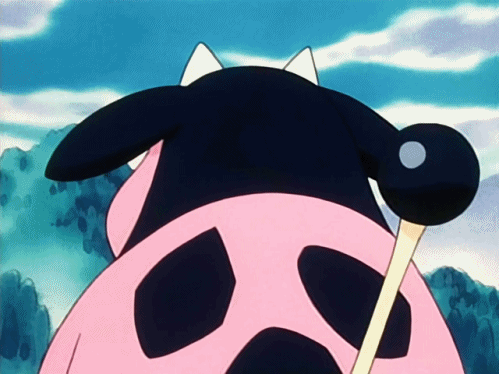
I myself am not a meat-eater, but I understand the importance of animal products to a society. If you world doesn't have it, don't fret. This sector won't just be about meat products, but it will contain a lot of it.
Food and what animals are considered for consumption changes from culture to culture. The same can be said for treatment leading up to their role in society as the food on people's plates. Often times a culture cannot imagining eating an animal they see as part of the family, such as dogs or cats IRL, but other times it's seen part of a religious practice such as cows.
There's a lot of cultural stuff that goes into our agricultural animals, both for work, dairy, textiles, and food.
Here's some ideas to start with
What parts of them are edible and used for food
Do they produce any dairy or egg products
How old do they have to be before becoming a produce animal
Are the animals used for other resources too i.e. bones, fur, skins, skulls, blood, etc.
How much food does one animal make
Typically how are they are killed, if they are
What conditions are these animals kept in and are they viewed humane
What environments allow these animals to thrive alongside the people of your world
What does the animal eat
Now... Let's into some culture and religion
Religion and culture has a major impact on what we eat. Take for instance Kosher, Halal, and more. Historical shortages in food even to this day affect what foods we eat. Culture also affects our tastes. The corn line of the United States is drowning in corn, and yet corn is seen as a sweet treat over seas in many nations.
Harvesting

How the harvesting goes changes a lot about a society, big and small. Think about how terrible a year would go in medieval times if harvest came up incredibly poor, or how wealthy our modern day world would look to those people due to mass production.
Here's some things to think about
What time of year are the biggest and most important harvest(s)
How common are agricultural workers
What would the average person see if they watched people work
What technology/tools are used
What happens if the harvest goes wrong
Do farmers/harvesters get special rights for their role in society
In older societies harvesting and how that went completely shaped how the next year would look. In some cultures the harvesters have been revered, while in other if crossed to far would be expected to tear the country to pieces. Think about the role harvesting plays in your society. What would happen if they striked? Or if a disaster swept the land?
The environment itself will change a lot about what harvesting look likes. Why does this environment work? What are the environmental risk to both the crop and workers?
Are we farming in the water, in the middle of the arctic, underground, high up in the trees?
Exotic Food & Immigration
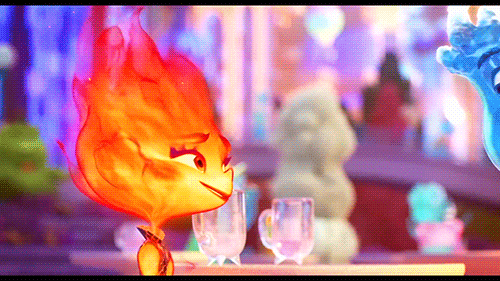
While establish what the everyday food in the area is, don't forget to pay mine to the opposites. Immigration and trade play a major role in what foods end up on our plate. As cultures combine and mingle so do their food.
Take one look at the United States, infamous for it's large potions, fatty foods, and immigrant culture cuisine. A lot of foods in the United States are the results of cultures meeting to improve and add onto one another's foods, that includes American styles of pizza, tacos, and more.
Even major cities around the world have styles of foods unique to them.
Let's think
What locally seen foods count as exotic
What foods are nearly impossible to get
Is there access to foreign brands/produce
How expensive is most exotic foods
What styles of cooking are being brought in by foreigners
How do people get exotic foods
What foods would the locals not be able to eat due to not being used to it
Try to think about what makes this food exotic in the local area. Maybe it cannot grow in the local environment. Maybe the quality of the food is simply better overseas. Maybe the animal or plant is far too aggressively invasive for locals.
Trade & Transport

Food is both a very important export and import, especially in time of devastation.
Don't forget about exports too, what is your society giving out to the world, and getting back. Not all trade has to be capital based. Perhaps your world simply trades on good or service for another.
Here's some things to think about
What's being exported and imported
Are whole animals imported/exported
How is the trade being done i.e. trains, boats, aircraft, teleportation, etc.
Are there any obstacles to trade
What places are all involved in trading
How is the trade brought to where it needs to be inland
In what ways do these trades improve the lives of locals
Transportation is also super important to where food ends up, and more so in what volumes. How do people get all these produce or animals relocated? What kinds of storage are we seeing to keep things fresh (if health standards are even up to code in your worldbuilding)?
What poses a threat to things in storage? i.e. mold, foxes, animal thieves, disease, etc.
Restrictions

With supply and demand, comes outages, taxes, and restrictions. Unfortunately not everything in the food world goes right. There's natural disasters to come and destroy crops, hostile settlements to block trade, and especially that person who is really bad at cooking but they love doing it so you don't have the heart to say no....
Anyway let's talk restrictions and where they can come from
Wartime
Wartime can cause a lot of original farmers and workers to become soldiers. It also can lead to the large scale destruction of precious farm land, crops, animals, and overall places to cook.
Laws
Perhaps there's a particularly poisonous food, and way too many suspiciously poisoned people. That's when law comes in. There's many reasons for food and drink to become outlawed. Religious reasons, danger, regulations, inebriation, etc.
Siege/Embargo/Thievery
Knock knock! It's the United States here to embargo your random country. Outside factions can always become an obstacle, leading to loss of traveling cargo or straight up missing farmers too. Nothing comes in, and sometimes nothing comes out.
Endangered
Perhaps a common plant or favored animal is running low on populous. Now locals are more so focused on reanimating a dwindling population, more so on eating it.
Sickness
Whether it be hoards of invasive bugs, prion disease caused by cannibalistic animal feed, or sudden inexplicable field of dead corn sickness happens. Maybe something has swept over the land, and no one ever bothered to try to plant said crop again.
Natural Disasters
Natural disasters can not only cause the elimination of entire villages, but accidentally bring in lots of invasive creatures too. Catfish is off the menu for as long as carp is intown.
Straight Up Difficulty
Sometimes a fruit appears once a year, or a tasty creature is a dangerous one to take on in order to eat. It can be difficult getting the right ingredient sometimes. Other times it's new to the market. So much can happen when food is involved.
Preparation & Flavor

Finally all the food in the world is available, but what are we going to do with it.
Make it even better!
I personally find preparation to be the best part of worldbuilding. Now I get to imagine my fictional little people stewing their pots, and kindling their fires. Reflect off of real world recipes, and maybe even write down exact fantasy recipes of your own.
Don't forget about herbs and spices (I see you British people).
You have five basic taste receptors in your mouth: sweet, sour, salty, bitter, and savory. They make great descriptors and fun places to explore when looking into what your foods taste like. Smell can play an important role too.
Does it smell awful and taste great, smell sweet and taste bitter, perhaps it doesn't have anything at all going on.
Happy worldbuilding!
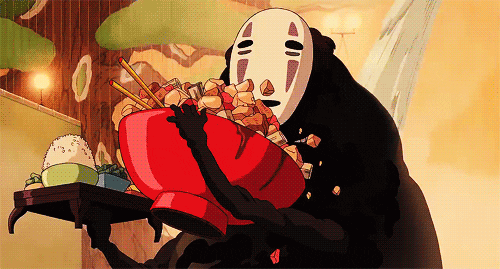
#food#world building#worldbuilding#worldbuilding food#writing#writing food#world builder#writing tips and tricks#fantasy writing#fantasy worldbuilding#long post
47 notes
·
View notes
Note
do you have any advice for writing a story set in the future? like a story ab immortal characters that has a 100 year time jump where you can see the differences from say present day NYC to NYC in 2123 but its not outlandish or unrealistic
How to Write a Story Set in the Future
The future is a blank canvas, a place where anything is possible. This can be both a blessing and a curse for writers. On the one hand, it gives you endless possibilities to explore. On the other hand, it can be difficult to know where to start. Here are our quick tips:
Start with a strong idea
Decide what kind of future you want to write about and what role you want technology to play. Do you want to write about a dystopian future where technology has taken over? A utopian future where humans have solved all their problems using technology? Or has technology completely failed, and the future in your book looks more like our past?
Once you have a strong idea, you can start to flesh out your world and characters. Knowing how you want your future to look is the first step in knowing how to get there.
Do your research
The more you know about the present, the more believable your future story will be. Read books and articles about current trends, and think about how those trends might develop. You can also use your imagination to come up with new technologies and ideas, but they should be grounded in realistic development and fit within your story world.
There are some amazing non-fiction books to help you get the science right in your fiction, but you can also draw inspiration from the way that fiction authors tackle the subject. You can find a list of recommended non-fiction books to get you started in this post.
Be specific in your worldbuilding
When you’re describing your future world, don’t be afraid to get specific. What does the technology look like? How does it work? What are the social and political implications of this technology?
You don’t necessarily have to include all the minute detail in the content of your story, but knowing it for yourself, so it informs the way you write and what you can assume your characters know, will help you build out a stronger world.
The more specific you are in the world you build, the more immersive your story will be. But, focusing too much on the minute detail of your story will affect the pacing, so make sure you share only what is relevant.
Consider the time period
How far in the future is your story set? This will affect the technology, culture, and social norms of your world.
A world 50 years in the future will look very different from a world 2000 years in the future. Compare our current reality with the late 20th century vs the beginning of the 1st century, and you’ll see how big a part this can play in the way your story develops.
The rate of technological development in your setting is also important to consider. Will technology develop at the same pace as it currently does? Or will it stagnate or decline? If so, think of the reasons why this might be and how it fits into your plot.
Be creative
Don’t be afraid to come up with new ideas and concepts. The future is unknown, so let your imagination run wild.
But, with that said, there needs to be some logic to your ideas. If your future contains bio-engineered lettuce that gives people superpowers, there needs to be a reason for that. A cool thing for the sake of a cool thing will often break a reader’s immersion.
You want readers to be able to follow your ideas and believe in them. So making sure they fit and work within the context of your story is just as important as being imaginative.
#writers#creative writing#writing#writing community#creative writers#writers of tumblr#writeblr#writing inspiration#writerblr#writing tips#quick writing tips#writing advice#writing tips and tricks#writing resources#writing help#help for writers#advice for authors#advice for writers#references for writers#writing the future#writers corner#story idea#let's write#learn to write
91 notes
·
View notes
Note
Hello! I'm a big fan of your network and I find your advice very soothing after a long day of studying. I was wondering if you can help ease some worries I have about a future career?
I'm from the states, and I'm entering into my final year of college. I'm planning on becoming a teacher for middle school (unfortunately I'm unsure of what you call it overseas where you are? I want to teach the age range of around 12-13 year olds. My apologies). I've really enjoyed the program so far! I've made quite a few creature friends entering into the career as well, both in and out of my genus.
Unfortunately, there's some harmful fear-mongering and stereotypes surrounding my genus, specifically with regards to kids? And they're just the most ridiculous, too? Like, these people think I'm gonna kidnap their kid and pull them to the nearest lake and drown them! Seriously.
Regardless, I'm rather worried about how they could affect me in my future career. I'm not very good at ignoring how people perceive me. While I was working as a lifeguard over the summer, I felt very on-edge and hyper aware of every sapio who looked at me funny. Even though many of these stereotypes are easily disputable, I've still seen quite a few articles spreading this misinformation alongside a wider surge of similar misinformation regarding other genuses. I guess my question is, how do I cope with this?
I'm sorry you're having to cope with this kind of prejudice, reader. Liminal culture in the United States is not – obviously – my area of expertise. That said, we certainly have our fair share of bigotry and anti-creature sentiment here in the UK, so I have high hopes I'll be able to help, at least a little.
The first thing I would stress to you is that it is far easier to be vocal in the name of hate than acceptance, and that venom and vitriol will sell more newspapers (or garner more clicks, as the case may be) than open-mindedness and a live-and-let-live attitude.
Do not mistake the loudest voices for the largest population. Very often, they have been artificially amplified by a media industry that knows the selling power of outrage.
Besides which, people are not generally speaking inclined to march in the streets and wave home-made placards at news cameras for the sake of telling the world, “This is an issue I have no strong feelings about.”
I don't think you should be trying to ignore this issue. But you need to be able to see it for what it is – a loud, vocal minority whose success is due more to the passive silence of the majority than any truth or charisma on their part.
After all, their beliefs are patently absurd! The world is full of aquatic creatures who manage to go their entire lives without drowning anyone – or at least, nobody who didn't deserve it.
Rather than ignoring these people, I think it would be healthier and more fulfilling for you to actively seek out ways to counter their ridiculous narrative.
Look into opportunities to get involved with cross-community education projects. Make your classroom an explicitly creature-friendly space. Support the children you teach and their families to learn more about liminal folk.
In short, let your own liminal life stand as example of the good that can come from mixed genus communities.
There will always be people out there determined to believe the worst of anyone they consider to be the “other”.
But with time, energy, and kindness, we can build a world where they are seen and understood for what they are – small-minded bigots more interested in making themselves feel important than in building any kind of lasting, healthy community.
And if they really get up your nose, remember: you can always drown them.
18 notes
·
View notes
Text
youtube
Science can answer moral questions - Sam Harris (TED, 2010)
If questions affect human well-being then they do have answers, whether or not we can find them.
And just admitting this -- just admitting that there are right and wrong answers to the question of how humans flourish -- will change the way we talk about morality, and will change our expectations of human cooperation in the future.
[..]
Now, many of you might worry that the notion of well-being is truly undefined, and seemingly perpetually open to be re-construed. And so, how therefore can there be an objective notion of well-being?
Well, consider by analogy, the concept of physical health. The concept of physical health is undefined. As we just heard from Michael Specter, it has changed over the years. When this statue was carved, the average life expectancy was probably 30. It's now around 80 in the developed world. There may come a time when we meddle with our genomes in such a way that not being able to run a marathon at age 200 will be considered a profound disability. People will send you donations when you're in that condition.
Notice that the fact that the concept of health is open, genuinely open for revision, does not make it vacuous. The distinction between a healthy person and a dead one is about as clear and consequential as any we make in science.
Another thing to notice is there may be many peaks on the moral landscape: There may be equivalent ways to thrive; there may be equivalent ways to organize a human society so as to maximize human flourishing.
[..]
So, this, I think, is what the world needs now. It needs people like ourselves to admit that there are right and wrong answers to questions of human flourishing, and morality relates to that domain of facts.
It is possible for individuals, and even for whole cultures, to care about the wrong things, which is to say that it's possible for them to have beliefs and desires that reliably lead to needless human suffering. Just admitting this will transform our discourse about morality.

We live in a world in which the boundaries between nations mean less and less, and they will one day mean nothing.
We live in a world filled with destructive technology, and this technology cannot be uninvented; it will always be easier to break things than to fix them.
It seems to me, therefore, patently obvious that we can no more respect and tolerate vast differences in notions of human well-being than we can respect or tolerate vast differences in the notions about how disease spreads, or in the safety standards of buildings and airplanes.
We simply must converge on the answers we give to the most important questions in human life.
And to do that, we have to admit that these questions have answers.
==
There are better ways to structure a society, and there are worse ways to structure a society. And we should stop pretending we can't tell the difference between the two, that there's just no difference and everybody's in the same boat.
26 notes
·
View notes
Text
Roundtable Presentation: We Don't Need Another Superhero

How do structural mythology, cultural studies, and cultural history reflect the series’ world and world-building around superheroes?
Supergirl’s true identity is Kara Zor-El, with her earth name being Kara Danvers. The show takes place in National City, and besides this world’s advanced technology and interaction with the extraterrestrial, it reflects a world much like ours. The politics of this world is similar in the sense that there are “anti-alien” political groups that lead the aliens of this world to find refuge in their own bars, neighborhoods, etc. In fact, Kara’s best friend, Lena Luthor, develops a piece of technology meant to identify who in a crowd is alien and who is not, a severe form of othering.
In what ways are the superheroes and their abilities informed by their racial, gender, sexual, and cultural identities?
One of the main challenges for Supergirl is coming to terms with her identity and finding space for herself in a world dominated by male superheroes, specifically her cousin, Superman (aka Clark Kent). During the destruction of their planet, a teenage Kara is sent to earth to protect baby Clark. However, Kara arrives on earth much later than Superman because she ended up trapped in the Phantom Zone, a dimension of space where time doesn’t exist. Thus, although Kara is older, Clark is already an adult while Kara is growing up with her adoptive family. In a world where a male superhero with identical powers is established, Supergirl has to work twice as hard to make sure she isn’t just known as “Superman’s cousin.”
Another way Supergirl is informed by her gender is through her interaction with other male characters. Most Superman narratives don’t typically focus on Superman’s love interest, and even if it does, it rarely has a large enough focus to affect the trajectory of Superman’s abilities. Contrastingly, the TV show Supergirl is packed with “damsel in distress” storyarcs, where she is often saved by one of her love interests. This is interesting considering one of the main themes of the show is feminism.


In what ways do costumes and concealing identities further separate the superheroes from normal society? How necessary is it for the superheroes to hide their true identities to successfully achieve their goals?
Supergirl's costume separates her completely from her actual identity, Kara Danvers. The importance of the costume especially comes to light when she is interacting with her boss, Cat Grant, and her best friend, Lena Luthor. Both characters have very different attitudes when it comes to Supergirl versus Kara. Cat Grant idolizes Supergirl and aims to secure interviews with her for her magazine while treating Kara, her assistant, with little acknowledgement and appreciation. Lena Luthor, who begins as friends with both of Supergirl’s identities, becomes both vengeful and terrified of Supergirl and strains their relationship even further by developing anti-alien technology that could dampen Supergirl’s abilities. As for her relationship with Kara, the two are the bestest of friends until Kara reveals her superhero identity to Lena, leading to an extreme loss of trust between the two. For Supergirl, it’s extremely important for her to maintain a hidden identity so that her complex work relationships do not get mixed up with her personal ones.

How do the economic, political, and social events that occurred during the series’ creation and broadcast cultivate and inform the superheroes’ decisions and actions?
Supergirl aired in 2015, and in 2016, the election between Donald Trump and Hillary Clinton was the topic of the year. Thus, I don’t think it’s a coincidence that season two of Supergirl had more episodes surrounding the president than any other season. The President in the world of this series was a woman named Olivia Marsdin. However, one of the biggest shocks of the entire series was in the season four premiere, where The President was revealed to be a shapeshifting alien herself. This is especially interesting considering Trump’s stance on immigration during this time. In the world of Supergirl, this revelation threw the public into utter chaos and shock, especially because of the anti-alien sympathizers spread throughout the country. Although the President shows no immediate threat and has been running the country with its inhabitants best interests at heart, both human and alien, the Constitution leaves no room for the President to not be a natural-born citizen, let alone an extraterrestrial. The revelation tarnished the image of aliens all over the country, including Supergirl, and anti-alien extremist groups gained even more support, with one of the leaders, Agent Liberty, becoming the primary antagonist of the season.

How do the superheroes question themselves, each other, and their obligations and duties to the people around them?
Because she has to keep her identities separate, Supergirl often has to hide parts of herself from the people closest to her. Thus, when she’s able to share her full self with someone, it takes an extra emotional toll on her to lose them. During an invasion, Supergirl has to choose between saving the people of Earth from becoming mindless drones or losing the love of her life, Mon-El. Ultimately, she of course chooses to save Earth, but there is a moment where Supergirl questions whether all she has sacrificed for this world both physically and emotionally is worth it or not.

@theuncannyprofessoro
12 notes
·
View notes
Text
Building Characters That Actually Do The Thing
Hey yall! This week’s post is a little late! I had some employment complications going on that required a lot of working outside my normal work hours, but extra cash is extra cash!
Anyway, this week’s post builds off of last week’s post about building character arcs!
The Why
We writers love to think of our characters as real people that have their own thoughts, feelings, and motivations. Unfortunately, that is not the case. It’s good to think of your characters as well-rounded individuals, but they are also tools to propel the story.
When writing out your story and populating your world with characters, it’s important to know why each character is there. Characters fulfill certain roles in the story. Examples include protagonist, antagonist, and anti-hero.
Think about what happens in the story and why. How does the character affect the story's events, and how does that add to the story's themes as a whole?
The What
Last week we discussed static vs dynamic characters and writing change with intention. This is the most straightforward part of developing a character: what is the character like? What are their main traits, and how do they change, if they change at all?
Who is your character as a person? What are some important traits of theirs?
Note: “important” can mean a lot of different things. What traits are important for the story? What about to the character themself? What is easily noticeable by other characters? These traits are good to sprinkle in through description, action, and environment.
Spreadsheets are a great way to keep track of characters and their unique traits.
The How
Stories are built on conflict and characters drive that conflict. But it’s hard to have a conflict if every character speaks or acts the same way. Each character should have their own voice.
Voice refers to the way the character behaves or speaks that helps them stand apart from the other characters around them. Voice does not necessarily refer to an accent or style of speech, but it certainly can include those.
I like to think about characters and how they communicate through the lens of what is important and familiar to them. This builds off of The What section pretty easily. A list of character traits, values, and mannerisms readily available makes it easier to develop a unique voice.
For example, a character that grew up rurally or on a farm might use metaphors and language invoking natural elements such as the weather or fields and forests. Different characters will have different ideas of “normal.” Consider the cultural difference between what an American and a European think a “day trip” is. Americans may call a four-hour drive to a beach for a few hours and then a four-hour return trip a “day trip.” A European might consider 45 minutes the maximum one-way commute for a “day trip.”
Conclusion
Your characters are not people, and every fact about them is a decision made by the writer (you!). So think about why the character is there, what they do and who they are, and how they express themselves in relation to their character, and you’ll be building a character with a deliberate, compelling arc in no time.
-- Indy
27 notes
·
View notes
Text

🦇 Women of Good Fortune 🦇
❓ #QOTD If you could pull off a heist, what would you steal? ❓
🦇 Lulu, Rina, and Jane have long considered themselves The Leftovers; non-married women considered far past their prime by Shanghai’s society. Now luxury-focused Jane is trapped in a loveless marriage, career-dedicated Rina keeps getting passed over for promotion, and Lulu is engaged to Shangai's most eligible bachelor. Lulu's wedding is their golden opportunity to get what they've always wanted: freedom from the standards and expectations that have trapped them for too long. The cash gifts from Lulu's wedding could transform their lives...IF they can get away with it.
💜 Sophie Wan's debut novel is a stunning study of how society treats women--and the hoops they need to jump through to make a life of their own. Each woman has her own distinct motivations and own clever voice. The real focus of the story is the found family these women built between them, their friendship stronger than the strain society's expectations set on their shoulders. Wan explores a number of important themes, including sexism, beauty standards, classism, and the weight of familial standards. While the romances in this story aren't the main focus, Rina and Vic's enemies-to-lovers sub-plot is the primary source of humor and entertainment. Each women grew to reconsider their primary motivations, leaving us with beautiful character development.
💙 For a heist story, this novel is all tell and very little show. The lack of descriptions or layered character-building makes the story dry and distant. The women only have one primary focus each, making them very one-dimensional and unrealistic when they could have been layered, diverse characters. We're given very little time to connect with them on any emotional level, making it difficult for us to root for their success. The pacing drags as the story establishes each character's world, stressors, and motivations when a heist story should feel action-packed and fast-paced. I love stories that delve into different cultures and provide us with an intimate look into someone else's point of view, but most of the cultural details are rushed through, as if readers would already understand them. I wanted so much more from a diverse, women-centric heist story.
🦇 Recommended for fans of Ocean's 11 and Crazy Rich Asians.
✨ The Vibes ✨
🧧 Heist Story
🧧 Sisterhood/Female Friendship
🧧 Chinese Culture Rep
🧧 Multiple POVs
🧧 Debut Author
🧧 Wedding Story
🦇 Major thanks to the author and publisher for providing an ARC of this book via Netgalley. 🥰 This does not affect my opinion regarding the book.
💬 Quotes
❝ It's helped me to see how much we let the people around us inflate our views of something that might be objectively worthless. ❞
❝ Purpose is something you choose. You can't rely on others to give it to you. ❞
#books#reading#book review#aapi authors#booklr#debut novel#batty about books#battyaboutbooks#book: women of good fortune#author: sophie wan
2 notes
·
View notes
Note
Do you think that the Smt series is a genuine critique to our current world and its socio-economic state? Or is it a bit over analyzed by the fandom? I’m having an hard time believing that these games are a deep and complex look into our societies and morals, especially in later entries, considering the total lack of subtlety regarding certain topics and their writing quality. At best they seem to analyze only Japanese society and even then in a very simplistic way.
I think this was most successful in SMT1.

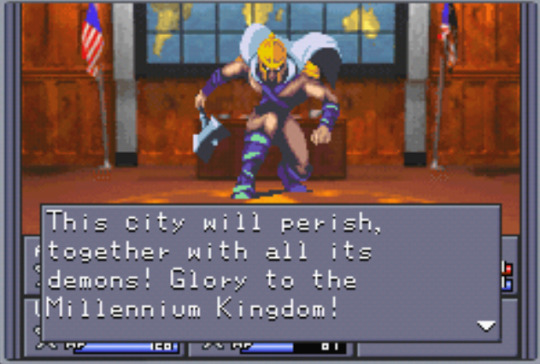
Compared to MT1 and MT2, SMT1 begins in an entirely contemporary setting (for 1992). Japan's economic bubble had begun bursting during the game's development. The big questions are (broadly) about choosing a traditional Japanese identity or allowing it to be buried by the Western/American trends of the time (incl. movies, music, fashion, etc.).
Of course, the game already answers the questions for you via Neutral, in that the most sustainable option is balance: being a modern Japanese person is both enjoying seasonal festivals and listening to Pink Floyd. And this message of balance is delivered to you by none other than the Chinese deity Taishang Laojun, itself a reminder that much of Japan's traditional culture was influenced by or imported through China and India.
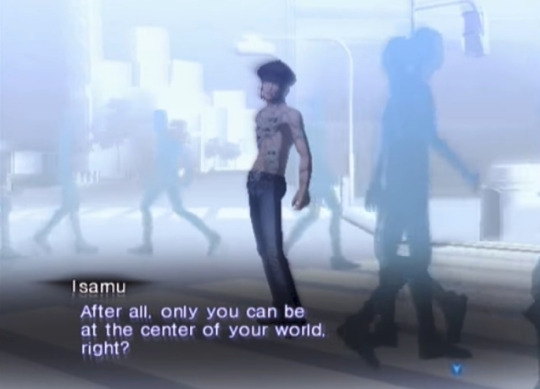
While I'm unsure about SMT2 (I've never given it any thought re: contemporary society), it's probably no coincidence that SMT3, the first game after the burst bubble's resulting "Lost Decade," features a character like Isamu whose goal is to be a supernatural hikikomori. SJ has its climate change & general anti-excess message, though I've never played through the game with this in mind.
And then we get to SMT4 and beyond and, well, yeah, lol... to be fair though, SMT4 definitely has a message, it just sucks. So at the very least, I think it's undeniable that attempts at critiques of the modern world have (at least) always been present in SMT. They're inherent to the modern setting in the first place; why bother with such a setting if it's not going to affect the story and world-building in some way?
Do fans overanalyze things? Sure, but to what degree depends on the claim. Are my SMT1 thoughts above also overthinking? Entirely possible. But I think the most successful and convincing analyses consider foremost the contemporary events and culture surrounding any particular game's development and release.
40 notes
·
View notes
Text
As the country lurches forward into what I’m predicting will be a decade long conservative reaction against LGBT people, I can’t help but feel a little defeatist about our prospects.
I do not think trans activism, the way we understand it, will last as a cultural movement. Certainly not with popular support.
That being said, this isn’t going to usher in a new era feminism but rather a conservative reaction to anything and everything LGBT as well as an accelerated return of women back to their “traditional” place. An excess of left radicalism will be blamed for the rise of transactivism leading to a banishment of these things from public life. Child transition is the major flashpoint.
This is obviously already happening but I think things will accelerate and even liberal strongholds will become affected.
While I agree with some of the immediate effects of new conservative bills limiting access to transition care, I don’t like how much power conservatives have gained around this issue and I especially don’t like how organized queer and trans organizations have been unable to fight this.
Here are some things I do believe will stick around:
-Transition as conversion therapy for GNC gays and lesbians will not only continue but may become even *more* institutionalized. As LGBT backlash gets worse, more and more gay people will see this as a preferable “alternative” to living closeted. As a more patriarchal world becomes the norm, GNC individuals from the past will be automatically assimilated into a trans friendly framework making gender and sex seem inevitably intertwined meaning that LGBT people will lose examples and a sense of themselves outside of the trans framework. As backlash grows against gay people and Queer Politics, gay people will want to escape and hide. Im considering closeting myself again at work in New York, can’t imagine other gay women can’t feel the pressure from both sides all around the country.
-the widespread idea that if women don’t like their objectification, they are not women and that, to “be” a woman is to agree with misogyny. This will be reinforced and institutionalized with extreme public pressure to have children. There is an unholy alliance brewing between pop culture “anti capitalism” and “traditional values people”. Zombie Cottagecore.
So, what can we do?
There are 4 prongs we need to have in order to effectively fight this.
1.) CHANGING THE NARRATIVE:
Propaganda works, images, slogans, stories, songs works. We wouldn’t have misogyny constantly beamed into our eyeballs if it didn’t.
One of the most important things Marxist Theory has taught me is that individual people are responsible for their own collective liberation. Deeply internalize the mindset no one is coming to save you and things will keep getting worse. We save us.
That being said. We need to be ready to get more open, to be more bold and especially to demand that the more financially comfortable and established of us declare their allegiance to this movement.
This is a fight that is won through social networks and solidarity but we can’t form those networks of support without knowing who we all are. Be smart, take care of yourself, but really take stock of where fear is holding you back vs. good sense.
There are millions of women who can feel something is wrong, who feel uncomfortable in our male dominated world.
2.) GET THE GOODS AND INSTITUTIONALIZE OURSELVES AND GET CHECKS (again) :
Look, I am a communist. Nothing makes me more exhausted then the absolute minefield that is changing laws, building orgs and getting funding for our projects by manipulating politicians and trying to convince horrible, evil people that it’s in their best interest to support us. I’ve worked in mainstream politics before and I hate it.
But we need avenues to protect ourselves as we accomplish goals three and four, two is a stepping stone. Most importantly, we need to protect women from losing their jobs if they speak out. We need to create ways to protect private political speech and protect women who refuse to go along with misogyny on the job. This means bail funds, legal action, petitions, protests, news stories, actions etc...the works.
3.) BUILD AUTONOMOUS POWER/ UNITE ALL WOMEN:
I am still a ideologically a communist and not a liberal (this DOES NOT mean I think feminists should submit to the dictates of male led radical left) . What this does mean is that I do not believe reform is enough. I do not envision a future where men treat women well by choice. I envision a world where women are so powerful a man would shit his pants before acting up. A would were women are free. We must have real and solid power bases that only we can have access too.
We need to funnel money, womanpower and energy into both large women’s organizations and political parties as well as into autonomous women’s projects. Money, resources and labor. Money, resources, labor.
Living with men is a political choice, working for men is a political choice. Now, we all have to survive, so I don’t endorse shaming or blaming women doing the former but building roads to separatism needs to be at the front of our agendas. Supporting male dominance isn’t just “the way it is”, it’s a choice made to perpetuate the way things are now.
Many women do not see their continued support of political parties, organizations and charity organizations that endorse misogyny (both right and left) as a problem or even as a choice.
They also falsely see conservative women as the enemy when many socially conservative women can be easily flipped to our cause.
We need to be the alternative everywhere to everywoman and emphasize that we support both women in caretaking roles alongside women in other professions. What feminists do not support is male dominance.
Too often, left wing women are manipulated into supporting anti woman positions, like being pro pornography, making it easy for conservative women to distrust them. It’s important to underscore that we are for women and for moms and for female choice.
“Oh! You want to live your cottagecore dream?” Here is how you can do it without risking your safety.
“Oh! You want to go into business? Here is a whole network of industry contacts for you to work with.”
Women are not resource poor because we are stupid and don’t work hard we’re resource poor because we give all the good parts of us away to men, usually for free and this goes from women out in LA working in film, to women in education, to housewives. Men steal from all of us. Constantly.
And lots of women know that who don’t see themselves as feminists. We are protecting the fruits of our labor. Together.
I might become a mom but the tradwife life is not for me but I know there are lot’s of little Char’s growing up watching their moms try to be good little submissive wives (or rebellious wives like my mom) wondering wtf is wrong with them. Encouraging women involved in traditional roles to be autonomous can only have positive effects on the movement.
4.) CREATE SELF REINFORCING AND SELF REPLICATING SOCIAL STRUCTURES/FIGHT FOR THE FEMINIST FAMILY:
This is a neglected by necessary part of feminist vision. Not only should women control reproduction because it’s our right was women, it’s also how we can transmute our values to the next generation of young people.
How many second wave and third wave feminists ended up in a patriarchal marriage? How many others ended up in careers controlled by men and ending up adopting male supremacist ideologies? I know plenty. What do you think that taught their children.
Patriarchy is about Males controlling fertility. That’s it’s purpose. Therefore we need to ideologically capture mothers, motherhood and the childrearing process through rigorous support of female only co-living spaces, wages for childcare and dedicating ourselves to raising wages and working conditions for women in pink collar jobs. I want teachers and nurses to be respected (and paid) like Doctors and Engineers. Winning raises and increased financial autonomy for the masses of women will mean more money and ability of women. It will also mean children grow up cared for by, ensuring our success over and over for the next generations. It also means that women won’t have to seek male dominated career paths if they want cash money (and if she still does, we’ll have those sick autonomous female social structures, legal funds and orgs to help her navigate misogyny with as many resources as we can muster bc lemme tell you it’s a cruel ass world rn as a woman in a male dominated field).
Motherhood is expensive and labor intensive. Over 80% of women will become mothers in the US. Imagine if we could give 80% of women a fucking raise. Not just a raise, but the ability to completely walk away from the nuclear family model forever, without any negative financial consequences will undermine male supremacy at it’s very core. Leading not only to immediate positive impacts for women, but self replicating impacts for girls.
Even if say 30% of that 80% became serious feminists after that, it would be a huge, huge boon for the movement. In terms of reputation and power.
Boys won’t grow up seeing dominating fathers, girls won’t grow up seeing submissive mothers. Children will be neglected less, less likely to be sexually abused and cared for better across the board.
Mothers would be abused less, have more time for themselves, have stronger negotiating power at work and be more self reliant. Increased purchasing power means the market will pivot to cater to their needs and perceptions, shifting popular culture further away from misogynistic depictions of women.
This sounds like a big goal, but I think it’s more achievable then we think it might be and imo it can be pretty easy to exploit a lot of the tradwife rhetoric to convince women that our way is better. I’ve gotten A LOT of enthusiasm from conservative moms over this idea but the fun thing is, if we’re able to organize women as both unpaid care workers and paid professionals-we can undermine male power over women in the domestic sphere and in the public sphere, undercutting patriarchy and making it weaker over time.
Anyways, a bit of a long one but Tumblr won’t let me break this easily into small posts.
#radical feminism#radfem#radfems please tough#marxist feminism#socialist feminist theory#radical feminist theory#feminism#terf safe
9 notes
·
View notes
Text
This got brought up during a conversation with a friend last night, and I realise it’s important to say here.
The way we treat improvement in online art culture, art culture in general but especially online, by only measuring technical prowess is deeply harmful. This issue is not only harmful to beginner artists, whom this most affects, but also wreaks havoc on the minds of even those well entrenched.
We do not emphasise enough how important it is to be comfortable with the physicality of art; how much of art is coordination, and positioning, and finding a comfortable environment: both in a spacial sense and psychological sense. Time and time again, we push for this self-flagellating, motivation-via-punishment strategy, both from ourselves and from our peers, in a hope that this strife shall motivate us, and time and time again it wreaks insecurity, pain, and even total abandonment of the craft altogether.
Look at the state of the online art community. Take a look at any big Youtubers or prolific Instagram posters, and see how many of them continuously breed an environment of self-disparagement and dissatisfaction. How they, intentionally or not, pass these values onto their audiences. I’ll never forget when in one of her art tip videos, Lavendertowne said it was better to improve and be dissatisfied, rather than stay at a certain level and be comfortable.
Just what do you think art is for?
I was fortunate to have come along in my own journey to see this advice for what it was: harmful. Dissatisfaction as motivation. And some people manage to propel themselves off of that; clearly, Haley had. But what this advice either fails to consider, or does so as a form of weeding, is that this shit will utterly decimate the will of anyone not masochistic enough.
That this can and will cause the stagnation they are oh-so fearful of.
It’s sickening.
I hate how much capitalism has fucking twisted online art culture. That it’s turned the beginners on themselves and set them as rabid dogs on each other, and uplifted an Elect Few as flagellant martyrs, bearing the light for all who follow.
The simultaneous lie that art can only be achieved by those born with an innate talent like myself, and that also, if you work hard enough, beat yourself up hard enough, you’ll finally earn your worth. This emphasis on scarcity, whether inborn or dragged up by the bootstraps, either way serves the same end: to deny the fact that art is not special.
That art, just like cooking, is fundamentally human; we all do it, whether it’s prepping instant noodles, or drawing a stickman.
Let’s unpack that, for a moment: the stickman.
Do you know just how much is stored there?
A basic understanding of form, of emphasis on key features(prioritising the head, leaving a potential for emotion), the way it taps into human identity, the fact it’s flexible and can easily be changed-- Hell, alot of humanoid guidelines can be boiled down to stickmen with varying levels of buildup.
It’s so fundamental.
And yet we can go even deeper than that.
Think about how universal the experience is of just drawing shapes. How many of us picked up a crayon, or a twig, or a ballpoint pen, and ran absent patterns over the plane of our medium-- How then they’d allow us to go further, and relay the things we saw around us; whether solely for artistic pleasure, or as a form of preservation; and how neither are entirely divorced.
How my little cousin, scribbling with my coloured pens, is doing the same thing I do in my notebook and on my computer, the same thing Leonardo did with his pencil and his paintbrush, what artisans in the Americas and all over did when decorating their pottery, when they inscribed it, as we all do, with that human soul, and what humans have been doing far, far beyond recorded history, possibly before we were even human.
How essential something like this can be in building hand-eye coordination, another thing that is often neglected in this discussion! That not only are you struggling with technique, but also breaking-in those neural pathways; getting your arm used to these simultaneously repetitive and yet fluid motions. I? I don’t do proper lineart-- My hand is too loose. I’ve tried, and I’ve done it, but the experience was miserable, and there’s no need to put myself through it just because that’s “procedural”.
Your art, at the end of the day, is for you. You may show it to others, and do what you will, but at the end of the day, when the sun goes down, and it’s just you, and your pen, or your stylus, or your paintbrush, or whatever, it’s for you. Whether you started out with “pure” artistic intention or not, here is that.
And it may take awhile to break that in. We’ve made art, even private, into such a performance. Sketchbooks are not meant to be these neat, orderly things-- They can be, and that’s beautiful! --But in a sense, they’re more akin to something as a diary. A little place to pour the soul; to wander where you may, unfettered and unbound.
There are no rules here. There are guidelines. Nothing more.
Take what you will, and go forth.
If you’re struggling to make progress, and you’ve assessed that you do infact want that progress, then consider it’s not technique you need to worry about, but enjoyment; comfort, a degree of assuredness.
You won’t backslide into incoherency if you take your pedal off the break. Let yourself adjust to the road ahead, and drive where you may. And it will be awkward! And it will feel uncomfortable! And you will have those horrid moments where you’re ripped out of your own view and see yourself through the lens of some nebulous judging entity on the outside!
But allow yourself to ignore it.
Because now, you can take your art on your own terms; not on art Youtuber’s terms, not on your disapproving social circle’s terms, or whatever overly-hopeful expectations have been set on you because that’s what we as a capitalistic society do to people displaying any sort of prowess or potential of; Yours.
You deserve to be comfortable with your own work. You deserve to look at something, and feel however you may, and feel as though it isn’t a big deal. You are allowed to find pleasure in just being. That is what art is for: to answer the longings of a yearning soul.
Go forth, love of mine,
And be.
#scrawny rambles#scrawny speaks#art community#legit taking the foot off the brakes and allowing myself to write without a care was what saved that for me#art has always been a stim so even in those unsteady deeply frustrated early years i'd picked up on this fairly quickly#and without much thought#and i get the sense that because this is so often entirely unspoken#that it causes this weird rift in experience#irregardless of prowess#if you're the sort of person who loves challenging and pushing the limits constantly#then that's great!#but i think alot more people need to take it easy#this isn't a competition#this is just another one of thos Very Human Things#the fucking dick grafitti on the underpass walls is just as much art as anything in the louvre#a desire to express in forms somewhat abstract#calling upon form to relay information#and sometimes said information is a sense of great awe#or it's a disgusted eyeroll or juvenile snickering#who cares. everything has its place.#just live.#there's only so much time and you deserve to live it with just a little less worry#one shackle unclasped at a time
68 notes
·
View notes
Text
Gabu Heindl: No To The Discriminatory Architecture
We are leaving the 2023 with the last Weltraum in this season. On the Independent Coastal Radio NOR we hosted Gabu Heindl, whose architecture says yes and no. Yes to the design of public buildings and infrastructures, cultural and educational buildings. No to chauvinistic, racist or discriminatory architecture, to exploitative project proposals, suburbanizing single-family houses or speculative buildings. All projects are positioned in the urban cultural environment from film, art, theater and music to kindergarten, school building and social housing.

Gabu Heindl | Photo © Katharina Gossow
***
What relationships in space create chauvinistic, racist or discriminatory architecture?
Gabu Heindl: I've written this statement on my website and it's been a bold statement to remind myself trying to see how architects can be less complicit in chauvinist building of our environment in supporting racist housing politics, in engaging in discriminatory or defensive urban space design. It is something that should assure us that we can actually as architects ask ourselves to what extents we can contribute to a less racist, to a less chauvinist, to a less discriminatory world.

Extension of the self-organized housing project Planet 10
Which approach you follow in creating and defining your projects?
GH: I wish there was one path or one way of working. It seems every task, every project somehow asks for its own project development. But I do believe that thinking about project development affects what we do and how we could in the best sense accommodate the engagement of those whom we work with. I hope that we rarely consider it as working for but rather working with; hence we take sides for those who will use the space but not always is the client.
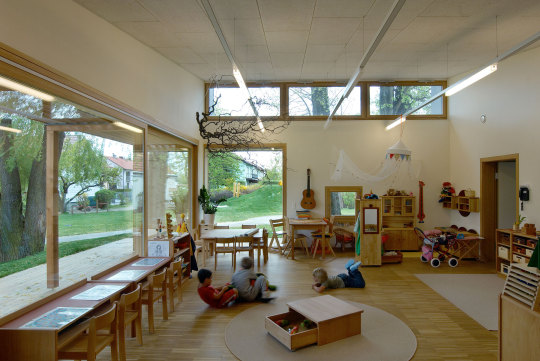

Extension of the Kindergarten Rohrendorf near Krems (2008). | Photo © Lisa Rastl
If you design a school or a kindergarten the client may be sitting in some office in Vienna organising school buildings. It's the kinds and the teachers who we actually have to speak to. And when it comes to self-initiated housing, which my office is more and more engaged in: affordable, non-market and co-housing, that specially requires a different approach. We are not taking a brief and just turning it into architecture, but we are developing the brief with people.
How living in New York changed your perception of the city?
GH: Of the general city maybe more than of New York I would say. I lived in Tokyo and in New York, which were the largest cities that I lived in, and then I lived in Amsterdam for some time. All of that was really not important to me because it was so to say my lifestyle ideal of being in the biggest cities, it was much more an idea to move to places to understand how it is to live there. I also had experienced life in a small village. Since some time now I am based back to Vienna. As I am now commuting between Kassel and Vienna I can say it all supported to understand this one idea: if a city allows you to live well when it comes to affordable housing, public space, schooling, healthcare etc. this gives you freedom to be independent, freedom to choose what you want to work on. This is what I found really until today the best to experience in Vienna.
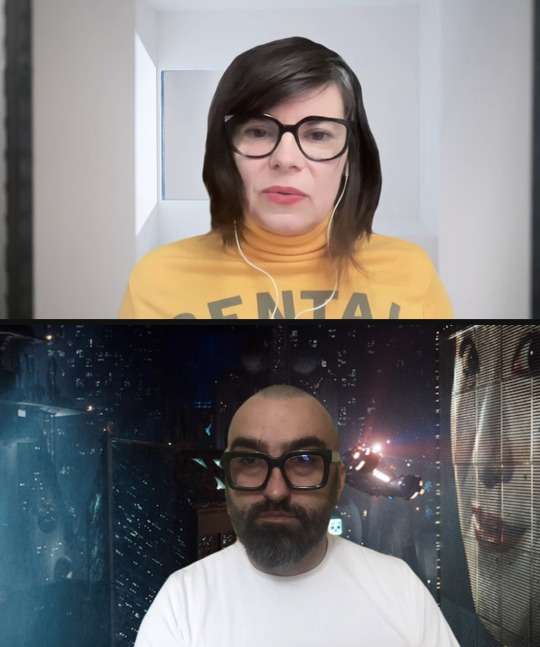
Gabu Heindl in discussion with Boštjan Bugarič
What about Vienna?
GH: I have the possibility to join the activism of some of my friends in Vienna who are fighting racist exclusion of social housing and the discriminatory Viennese first policy. There are still welfare structures existing in the city and still to a lot of people, yet we are fighting for that they apply for everyone: having your basic needs not to become your existential worry. is important for everybody. everyone should be able to chose what they want to engage with, what and who to work together. Of course also for an architect, it makes it easier for me to not engage in work I wouldn't want to do just for the sake of earning money.
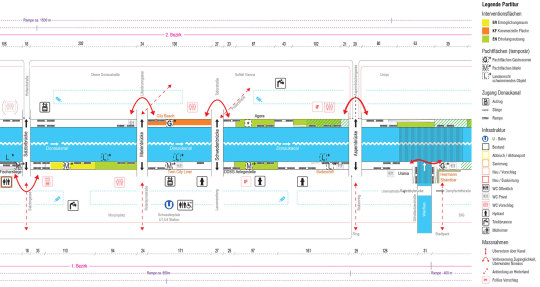
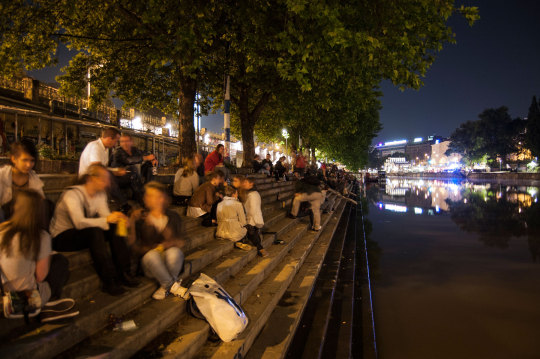
Donalkanal Partitur, the regulation and development guidelines for the Viennese Donaukanal In cooperation with Susan Kraupp (2012 – 2014). | Photo © Gabu Heindl
Yes, I think that's more difficult in New York, to come back to your question, but then of course also too many people in Vienna are still exactly in this situation that they don’t know how to pay rent or pay food at the same time at the end of the month. That is really what drives me, to fight for these basic rights of everyone.
What about the rest of the Europe, can you see the indirect discrimination?
GH: For sure, there is discrimination, still East-West, South-North, but also within cities. Every city that we are working in, in every city that we are critically mapping we can identify areas that have less infrastructure, that are less equipped, and at the same time it doesn't even mean necessarily that they are more affordable. That's the absolute tricky part, that exploitation comes along the exploitation within just the simple need of housing. Affordability does not relate to the quality of space. Yes, we need to speak about the rights to decent housing and a decent life for all the people in Europe – for everyone who is here and including people who will want or need to migrate to Europe in the future.
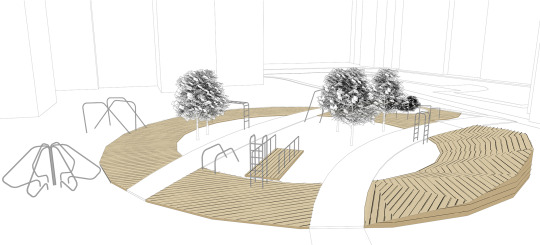
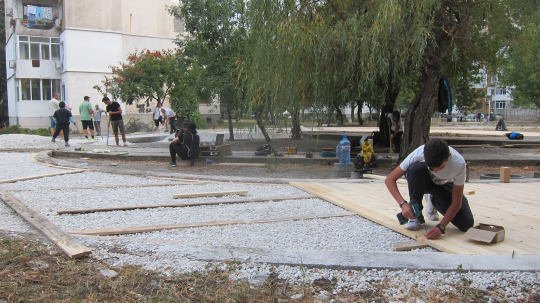

The Promises of Modernist Premises: Pool Trakiya is a collective re-appropriation of a deserted pool as communal outdoor centre in Plovdiv, Bulgaria (2016).
To combine the social question together with the ecological question means at the end of the day that there will be some new distribution and that also means that if we speak just about distribution of space some will have to actually to give up of which they have too much at the moment. That is the hard message that nobody wants to talk about. If we speak about living with less CO2 emissions, sharing more space then the crucial question is who exactly do we address? And we shall certainly not address those who already live on so much smaller space and means than others.

Architectuul organised a conference about social housing in Ljubljana, Slovenia in 2018 with Gabu Heindl, Frédéric Druot, Rémi Buscot (Atelier d'architecture autogérée), Florian Köhl, Davide Marchetti, Alessio Rosati, Alenka Korenjak, Anja Planišček.
In 2018 we had the opportunity to host you at the conference Collective Housing: New Initiatives in Ljubljana to share different knowledge of cooperative housing, knowledge that is lost because of being shame of ideas coming from Yugoslavia; what projects from Vienna did you present to be useful in Slovenia?
GH: I think every place itself has a history of common ownership model and I think what we are planning at this moment with my dear University colleagues such as Iva Marčetić at the Master Studio in Kassel is to really look into different common ownership models in different histories of different places. It's not about bringing a Viennese model to some other places or a successful cooperative logic that is established somewhere to be imported somewhere else but in a way all the cities can relate to a common other history or maybe sometimes supposedly lost history or an alternative history that they could actually revive. I am interested in what logics of common ownership and common ways of organising, also governance, or questions of how to produce together have existed in a specific place. And there I would say, we should much rather share maybe the histories of reviving, of maybe sharing experiences of how some of this knowledge has been lost but how it also can be recuperated, further re-invented, critically inherited.
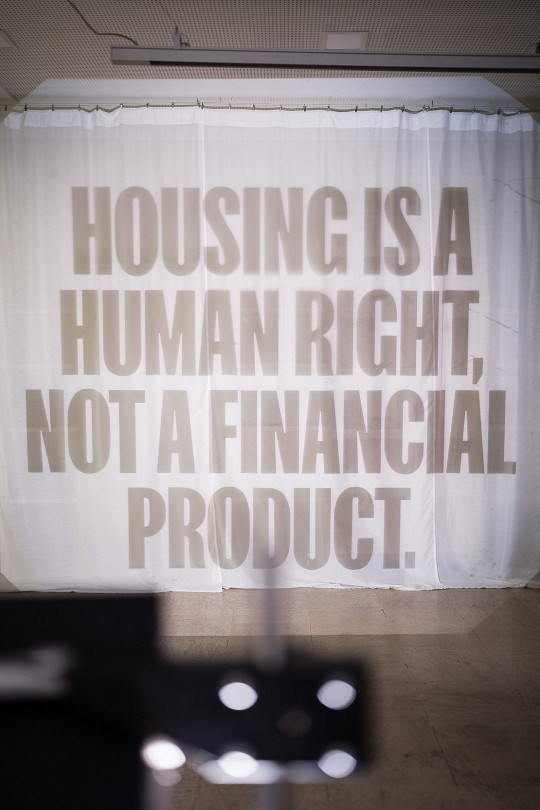
From the solo exhibition Urban Conflicts - A Housing Manifesto (2022). | Photo © Jan Prokopius
I studied the case of Red Vienna, which is a case of communal ownership housing models and with a supposedly successful continuity, and even there I did find alternatives in this already alternative history. If we consider Red Vienna to be an alternative case to so many cities of neoliberal housing development then even parallel to this public housing story you could find even more emancipatory, more feminist, more community-organization than top down housing provision. I am very happy that as an architect I can support activists and groups to self-initiate projects that have another solidarity idea than purely provision of standardised housing. I consider our work nearly as a reviewing of some of the historic emancipatory notions. If the groups I work with do so or not, doesn't matter. But we can see such a powerful agonistic drive in so many cities, especially if you think of the politics of all these powerful movements in Belgrade, Zagreb and so many cities in Southern Eastern Europe. Then I think there is a lot to learn for people in Vienna the other way around.
This question of mine was more a provocation.
GH: It really was. ☺
youtube
How do you see the work of women in architecture?
GH:I am really sad this still has to be a topic, and I am very grateful that a lot of my colleagues are actually working on this ever actual topic. I've seen my feminist engagement in architecture in looking into the very structural inequality not so much of architects but generally the structural spatial injustice between men and women and even more intersectionally with regards to class and race next to gender. I would try to always think these categories together. We need to look at what is happening in terms of accessibility to space, in terms of literally the possibility or rather impossibility to partake in anything, starting with being able to live peacefully, also affordably but also to take part in public space, to partake in the making of our cities, if we relate that to Henri Lefebvre for instance.

Radical Democracy in Architecture and Urban Planning PDF
In Kassel we are currently working on a project where we look into the interrelationship between the gender wealth gap and home ownership or freehold flats. The gender wealth gap is even wider than the gender pay cap. Looking at the trend or rather the political project of buying a home shows exactly how the structural inequality between men and women gets ever bigger. With little chance for wealth acquisition some people will never be able to afford to buy a house or an apartment. However, what we want to do is not to argue for every women to become as wealthy as some men but rather radically critique the idea of wealth and the constructed goal of owning an apartment and further look into common ownership housing, or “social property” and this comes again back to rental housing. We would like to develop good arguments against the idea of owning a home. With owning I mean to have a property title of it, but of course what we need to do is to have the idea of “owning” as belonging, in terms of that an apartment, a home is mine, I have the key, I have security, I will be able to live there and will not be thrown out, also that the rental price will not grow erratically. So in this sense we need to gain precision between the terms property and ownership and also the belonging to a place and all the security which should come with that.


Outside in Prison is an art project in a men’s prison courtyard in Krems (2011). | Photo © Gabu Heindl
We are highly inspired by Silvia Federici, who in the 1970s with a whole group of feminists were supporting the battle for wages for housework. But turned the battle even further and declared the slogan of wages against housework, said something like "we don't want just to be payed for house work, we want to change the logics of who is doing what sort of work and how we share it completely differently." Again I think the history of feminism has so much to offer for us, and how with their critical thinking we can do another turn and understand spaces within the logics of capitalism or also within the logics of white wealthy male.
How do you see yourself as an educator?
GH: The reason why I like to teach is because it is beautiful to see this young generation of students to be so political again. I can see how our generation has to keep up with the radicality that these kids are demanding and this is enormously empowering to see how some paradigm changes could really happen as well as systemic and radical rethinking. Our students literally demand demolition stop, they are demanding the stop of new construction as long as there is so much vacancy, as long as there is so much unused space. With this powerful force we are challenged to completely rethink what architecture is about. How can we engage in world without destroying so much, without using so much energy, without architecture being such a big part in emissions and all the waste production. When I took over the chair of ARCHITECTURE CITIES ECONOMIES | Building Economy and Project Development I realised that this is exactly where we need to be at this moment: to really redefine who and what project development does, how it could contribute to more justice, but also support solidarity and circular economies, the rebuilding instead of new sealing, concepts of using instead of owning.
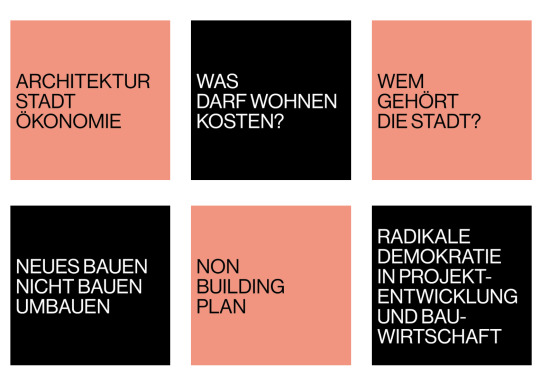
Master Studio Urban Conflicts in Housing Development at the Department of Building Economics and Project Development: Architecture Cities Economies in Kassel, Germany.
And if we do construct newly then maximally social and ecological and that's already a big claim, which we need to define properly. Just as much as economies: I hope that students think about financial economy not more than of commoning, feminist or foundational economies. There are so many other concepts of economy which have to come to the foreground again. And since my department includes the term “project”, which is such a modernist driven concept, we need to rethink it and that applies of course also to the term “development”. How to conceptualize development without growth? At then, very simply at the end, who is a project developer? I would love to empower students, and also activist – as that's what I do in my architectural work – generally to make people understand that they can all be project developers. There is not only Benkos; quite the opposite. We have to democratize the idea of project development with regards to the housing crises and the overshadowing climate catastrophe. It is great that the University Kassel gives me a chance to do so, it is an important moment to engage and contribute to this change.
What about creativity?
GH: If I speak about this concept of building economy people think that architecture doesn't need any creativity anymore. I would really like to emphasize that to repair all our built environment and to make it a livable environment for everyone and every species, we have to use so much creativity and design so many beautiful things. We shouldn't worry that to work on a socio-ecological transformation wouldn't need all of our creative energy, let's share it for a more caring and just world.


Disposing of Hitler: Out of the Cellar, Into the Museum. an exhibition at Austrian Museum of Contemporary History Vienna. | Photo © Klaus Pichler
***
Gabu Heindl is an architect, urban planner and activist in Vienna. As professor at the faculty of architecture she is heading the design and research department ARCHITECTURE CITIES ECONOMIES | Building Economy and Project Development at the University of Kassel.Her office GABU Heindl Architecture focuses on public space, public buildings, common-ownership and non-market housing as well as collaborations in the fields of history politics and critical artistic practice. From 2013 to 2017 she was chair of the ÖGFA – Austrian Society for Architecture. Gabu has obtained a doctorate in Vienna and studied architecture in Vienna, Tokyo and Princeton. From 2018 to 2021 she was Visiting Professor at Sheffield University with a research focus on Urban Commons and subsequently Professor of Urban Design at TH Nuremberg. 2019-2023 she was Unit Master at the Architectural Association School of Architecture (AA), London. Gabu lectures frequently and and has been publishing numerous articles and books including the co-editing of Building Critique, Architecture and its Discontents, Spector Books 2019 and the monograph Stadtkonflikte. Radikale Demokratie in Architektur und Stadtplanung, Mandelbaum 2020 (2022 3rd edition).
Here You can listen to the WELTRAUM interview.

#architecture#women in architecture#interview#activism#feminism#collective#collective housing#social justice#weltraum
4 notes
·
View notes
Text
Blog #6
Prompt:
There is no peculiar merit in ancient things, but there is merit in integrity, and integrity entails the keeping together of the parts of any whole, and if these parts are scattered throughout time, then the maintenance of integrity entails a knowledge, a memory, of ancient things. …. To think, feel or act as though the past is done with, is equivalent to believing that a railway station through which our train has just passed, only existed for as long as our train was in it.
When we consider nature interpretation through the lens of history, we need to consider whose history we are telling and why. What truths are being shared? What role does privilege play in this? What responsibility might we have to share the authentic voices and experiences of others who came before us and experienced the same nature in perhaps a different way? The story you share is but one of many. Being sure to include or mention others stories in your story. I think these are all important questions to ask when interpreting history, but also just as important to consider when reading or learning about it.
History is important because it creates meaning and context to the present moment. Nothing in our realities makes any sense and would not have been possible if it was not for the events that created the structures and ideas we all operate on; this is culture. History makes our differences make sense, and also allows us to achieve compassion for, an understanding of, and to celebrate our differences. It is through learning history that we can prevent mistakes from the past from repeating themselves, and create a better understanding of the conflicts we witness in the present day. When the quote talks about a train passing through a railway station I think this is referring to any event in history. It would be foolish to assume a train would only come by a station once. The train station represents the certain unfolding of events, or the present moment and the moving trains, the time and build up to the events that happen.The train is always coming to, is at, or is leaving the station. It's just that different people doing different things at a different time come through the station. The same story is never told twice, but any story could never have happened without its precursors. To make sense of modern day conflicts it is crucial to understand the various histories and the meaning of these histories to different people. That is one danger of today, and one of the interesting moral questions. We live in a world of informational access, one where we have a voice and a platform unlike previous generations did. It becomes a question of ethics however to voice opinions on events without a proper understanding of history and who is to be affected by an only partially informed voice. The more history, the more perspectives and otherness we understand the better an outlook there is for ourselves, our communities, and collective humanity.
In interpretation, it is important to present history in a way that is careful of other perspectives but to make sure that it is presented in a way that is relevant to the person learning about the history. To learn of events in the past without an understanding of one's own connection to them is poor interpretation. Interpretation should always call on someone's sense of self and worldview, they need to understand history in the context of the experience in which they learn it. Otherwise it is too abstract, unrelatable, and forgettable.
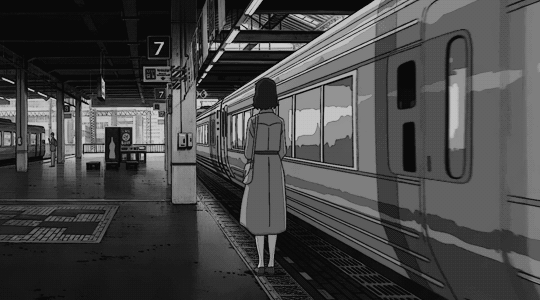
2 notes
·
View notes
Note
Happy Worldbuilding Wednesday! My question for you is: What key things do you keep in mind when you create the world and setting(s) of your stories? Do you get inspiration from real places and situations that you’ve lived in/experienced?
Happy Worldbuilding Wednesday!!!
I'm sorry for not answering earlier, there was a lot in my inbox, and I have been trying to do everything in the order that they were sent if you know what I mean! But I loved your questions! 💕
I'll try to answer each question here as best as possible, let's see:
What key things do you keep in mind when you create the world and setting(s) of your stories?
I would say that the key things I keep in mind are:
Looks, aesthetics, and environment
Culture, morality, beliefs, and societal values
Relationships with other kingdoms, wars, trades, and economic basis
If there are any localized dialects or entirely new languages that were once used in that place (e.g. Ancient Ildarith for the Hidden Elven Cities)
Real-life Ancient or Medieval Cultures, and what I can learn from them in order to create an entire fictional world with its own intricacies
Mythology, folk-tales, and customs of each kingdom
My Process is a bit like this:
Usually, I try to try and understand the overall looks, vibes, and aesthetics of the place I am creating, because once I know those things, it helps me steer correctly in the direction of the other things needed to fully build a setting.
I consider where - in the map of my WIPs continent - it is located, as that affects multiple things about a setting - a seaside town will have different customs from an inland kingdom, a kingdom near bountiful mines might be known for ore trading (see my Kingdom of Ergyre), a cold and unyielding climate generates different needs and even sets of beliefs (as such a ruthless climate might make people more self-reliant and valuing strength over other things)... etc.
Then I try to consider the societal values of each kingdom, their unique cultures, the local traditions, and politics, how their setting affects them, and see if they have any localized mythos based on their worldviews, as well as their relations with other different kingdoms. I try to then, have fun creating little curious details about each place, making sure I make each kingdom have a unique culture, set of beliefs, and morality. I try to think of a bit of lore for the kingdoms as well, important people and events that shaped them.
And, I try to consider real-life medieval or ancient cultures or facts that I can take inspiration from while creating the lore and aesthetic of the Kingdoms, but only as inspiration, to create an entirely new thing. Real-life settings and events can be adapted into a high fantasy version of them and changed to fit the new fictional world.
Do you get inspiration from real places and situations that you’ve lived in/experienced?
Since my main WIP is set in a fictional medieval era (and the other WIPs are set either in the far past, the future, or an alternative version of our current world), it is hard to draw inspiration from my actual experiences and places I've been to. BUT... I do draw inspiration from feelings I've felt in relation to certain places, and the many places I'd like to visit one day. It also takes quite a bit of research in order to adapt things into a completely fictional world. The same applies to my own characters, as I may draw inspiration from feelings I've felt in some measure - and exacerbate them to fit the context of my characters - but never actually experienced any of the fictional situations they're in.
In some cases I am also inspired by the many cultures that fascinate me, be it because I am in some measure related to said cultures in my ancestry or because I just find them incredibly inspiring.
I hope this answers your questions properly, and I loved every second of analyzing my writing process to write this answer! @rickie-the-storyteller
2 notes
·
View notes
Text
The rot consumes once again, and here I am, kept awake by Rain World Thoughts.
Tonight’s episode: The Void Fluid Revolution, the monarchy, and the absolute mess I think both of those historically were.
Frankly ridiculous length of lore below, so it’s under the cut.
The Void Fluid Revolution was undoubtedly an upheaval of the Ancients’ entire society, one likely beyond anything our world has ever experienced. Not only did Void Fluid serve as an incredible power source for industry and everyday life, it was seemingly a perfect answer to the desire for transcendence that had formed the foundation for their spiritual beliefs and much of their culture for a very long time.
Two white pearls mention a particular system known as the “hegemonic dynasty”, which doesn’t seem to be an actual thing, but based on the wording it’s most likely a kind of hereditary monarchy. This is already weird enough, seeing as the Cycle kept everyone from dying permanently, and no one even truly understands how it works - did monarchs reincarnate as themselves, with the ability to overthrow their own successors? Did they come back in a different body and need to fight for their throne all over again? Or is death simply a time loop, so that a monarch’s heir would continue their line without them, leaving the dead in their own timeline?
Whatever it was, by the time we get any substantial lore, I believe the dynastic system is long gone. The Ancients were fairly technologically advanced by the time of the VFR, considering their ability to build drills that could dig all the way down to the Void Sea, but it is said that the extraction of Void Fluid was what “started the big technological leap”, according to Moon. In real-life history, industrialization is strongly correlated with the emergence of democracy, and if the pre-VFR development wasn’t enough to push out the monarchy from power, the burst of industry and technology brought on by the discovery of Void Fluid’s practical applications would have mostly eliminated it.
With the last monarchs out of public power, councils of important citizens began to take charge - most of the evidence for this is close to the end of the Ancients’ existence, from the Shaded Citadel and Wall city pearls. It seems that family heritage still exerted quite the influence over politics, with the concept of houses sticking around and affecting what happened in these councils.
Admittedly, to this day, I have no idea what a living block is or why there are three titles associated with them. I think they’re a sort of city division that’s existed throughout history, as we see mentions of them everywhere from one of the white pearls that also mentions a dynasty, to the titles of a person who lived shortly before the final Ancients ascended.
(hold on I have to Google something)
Apparently in England, a Duke is the highest rank of royal peerage, all of which are personally given by the monarch. The title of Count comes somewhere after this.
In the Ancients’ titles, Count comes before Counselor, which comes before Duke. I’m not sure what this means, but Seventeen Axes, Fifteen Spoked Wheel was Count of 8 living blocks, and Counselor of an entire 16 (presumably Duke of none), while Eight Suns-Countless Leaves is Count of none, Counselor of 2, and Duke of 1. I think this implies that Duke > Count > Counselor, from the number of blocks each title was held over by each person. The terminology itself was likely a leftover of the monarchy, and may have come to refer to places on a council later on, as a representative for the blocks they were responsible for.
May add more in a reblog later, my phone’s dying and this post is getting so long it’s lagging Tumblr.
#rain world#help me i have too many thoughts#I swear I could write an entire history textbook on the Ancients I’m so obsessed with them#I currently have a page about the English monarchy and a research paper on industrialization and democracy open#I need to draw up diagrams for all this at some point#their social system intrigues me!! their history must have been unbelievably messed up and I must see it!!!#I don’t even know where this post went in the end#I need to give it a satisfying ending or I will explode#anyway I’m sleepy!! hope someone enjoys my unhinged ancientposting
5 notes
·
View notes
Text
“What Lessons can we Learn from Herodotus in our Daily Lives?
Answer by Joel Schlosser
On a summer evening at Point Reyes, California, a fellow wedding guest asked me what I did in the Bay Area. After a sip of my margarita, I replied that I was a graduate student studying ancient Greek at Berkeley – reading Herodotus, in fact. His face lit up. Herodotus!? He exclaimed. I love him. I’ll never forget one story in particular, he continued. Rhampsinitus, I think his name was, and the thief. I nodded. He retold this delightful story, which hinges on the thief’s father, who designs a treasury for King Rhampsinitus with a secret entrance. On his deathbed, he tells his sons about this secret and they plot and succeed – with twists both humorous and tragic – in robbing the king. I’m an architect, my interlocutor told me. Herodotus understood one of the great delights of my profession – those secret yet visible details unknown to everybody but you.
This story came to mind when I read and pondered the question of what lessons we can learn from Herodotus in our daily lives because it illustrates how there’s something in Herodotus for almost everyone. This architect found resonance in Herodotus’ attention to design and building. A doctor might have recounted Herodotus’ appreciation of Babylonian medical practices. An ecologist could marvel at his sensitivity toward different environments and their inhabitants. There’s something in Herodotus for everyone at the level of what Americans call “relatability,” lessons teach attention and appreciation toward the ten thousand details of daily life.
But alongside Herodotus’ wide-angle and wide-ranging lens also comes a set of ethical and political insights. To take one example, Herodotus illustrates the dangers of self-certainty, of believing that you completely understand a situation. Stories like that of Croesus, whose overly confident misinterpretation of an oracle leads to his demise, instruct readers about humility, carefulness, and the need to reflect on their assumptions and judgments. Solon’s famous advice to Croesus to count no man happy until he is dead underscores the lesson that life is not just unpredictable but complex beyond comprehension. Those in positions of power are especially prone to err because the pressures both of reputation and of leadership hasten ill-considered judgments. (As I have argued in the Research Bulletin of the Center for Hellenic Studies, Herodotus seems to favor democratic institutions that allow for equal participation of affected parties in decision making.)
Herodotus’ lessons come with yet one more level of complexity. The journalist Robert Kaplan published a wonderful essay in The Atlantic a decade ago that praised Herodotus as “a historian for our time” because of his appreciation of the complexities of culture and politics. Herodotus’ lessons emerge from specific places and times that must chasten our desire to generalize. Much like Plato’s dialogues, Herodotus does not speak directly but through illustrative stories, oracles, and historical figures whom he richly characterizes but remain at a distance from the author himself. Unlike Thucydides, Herodotus does not pretend to offer a “possession for all time” in his history. Instead, he presents his work as a demonstration of his inquiry.
Inquiry, then, may be the most important lesson of Herodotus. (Historia in Greek means inquiry.) This lesson applies both to how to inquire as well as what to inquire about. To inquire well, you must learn to look for yourself, in person if at all possible; to question the received wisdom; to ask those who know and then confirm with others. Yet inquiry is not just a method but an orientation toward the world, and Herodotus’ curiosity about not just human but nonhuman – plant, animal, terrestrial, and divine – phenomena illustrates where inquiry must be directed. If you confine yourself to one domain or discipline, you’ll fail to comprehend the complex interdependence of things – which could lead to your downfall. What’s more, if you restrict your inquiry to what you consider important or knowable, you’re much less likely to discover the delights and wonders around you. Who knows – there may be treasure awaiting just behind that otherwise ordinary looking stone.
For further reading, Ryszard Kapuscinski’s Travels with Herodotus gives a delightful example of bringing Herodotus into daily life. I explore Herodotus’s lessons for the 21st century in Herodotus in the Anthropocene. And on the richness of Herodotus’s stories, I find Walter Benjamin’s reflections in “The Storyteller” (collected in his book of essays Illuminations but available around the internet) endlessly fruitful.”
Source: the internet site of Herodotus Helpline (https://herodotushelpline.org/what-lessons-can-we-learn-from-herodotus-in-our-daily-lives/ )
5 notes
·
View notes